This simple Chinese congee recipe reminds me of the congee I used to eat when I lived in Causeway Bay, Hong Kong. It’s creamy, comforting, and only requires four ingredients to make.
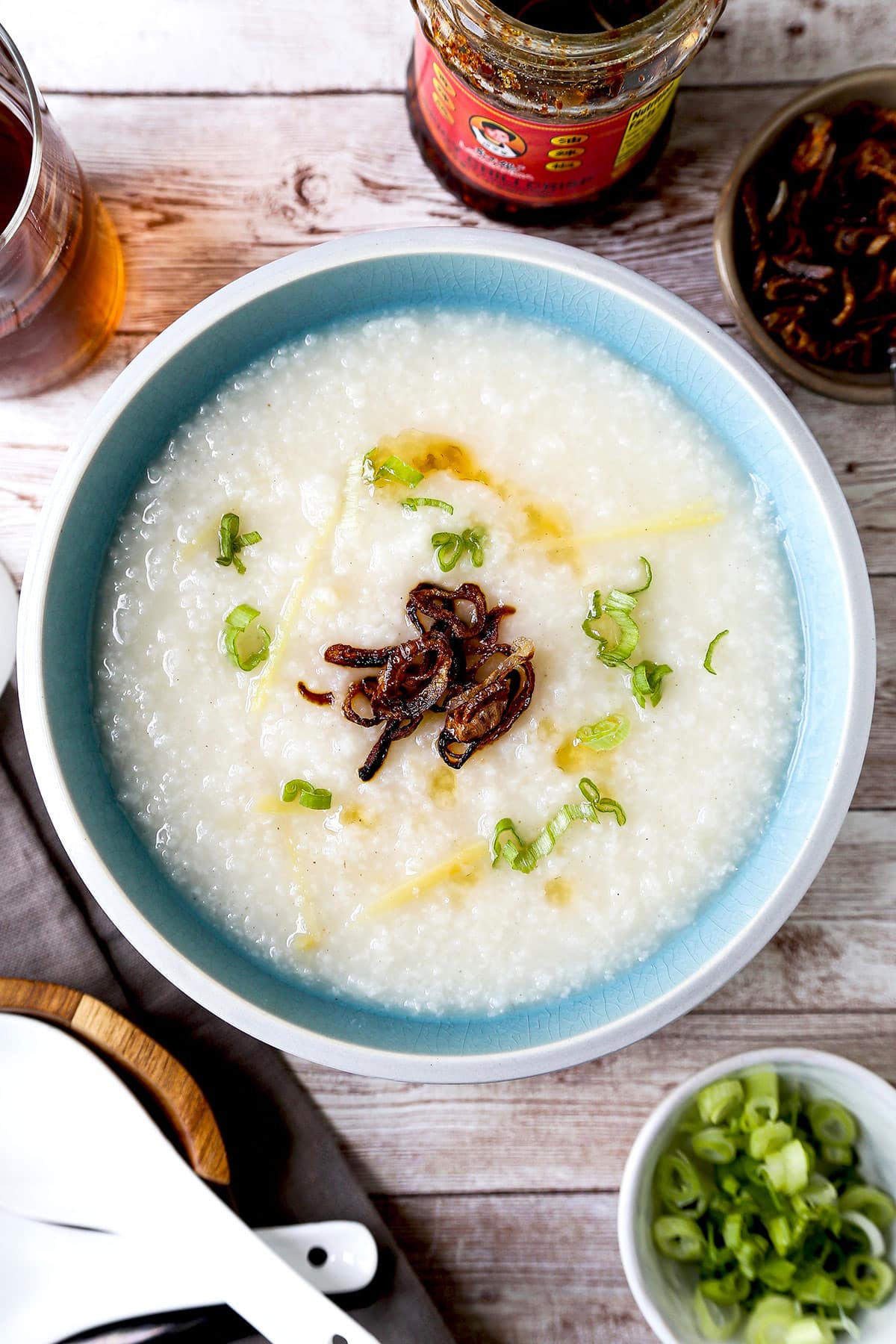
Congee, or Chinese rice porridge, is a dish I first discovered when I lived in Hong Kong. My tiny apartment was located in Causeway Bay which is a major shopping district full of luxury malls, boutiques, and restaurants. Everyday, as I made my way to the subway station, I walked past a unassuming restaurant that only sold congee.
After a few weeks of passing the restaurant I finally decided to give it a try. I looked at the menu packed with various congee flavors and toppings. Since this was my first time I decided to play it safe and chose the chicken congee. I expected to be underwhelmed by the entirety of the dish since, well, it was porridge, but instead was completely blown away by it. Congee is thick and creamy and the delicate chicken flavor was so soothing and satisfying. I became a congee lover at that very moment and have been making it regularly ever since.
Table of contents

What is Congee?
Congee is the Chinese version of a thick rice porridge. Simmered in broth or water, the rice grains are essentially overcooked to the point of disintegration. This is what gives congee its smooth and creamy texture.
Congee is most often eaten as a breakfast food in Asia. However it can also act as a base for a full meal packed with explosive flavor depending on the ingredients and toppings you use. It’s also a popular comfort food to eat when you are feeling under the weather. Think of it as a mild meal akin to the chicken soup you might turn to in the West when you’re feeling poorly.
Rice porridge goes by a ton of different names throughout the Asian food world – and the regional differences are all wonderful! In China’s Guangdong province, its congee – but in Cambodia its called bobar. Then, Japanese rice porridge is called okayu, while in Korea its jook (or juk).
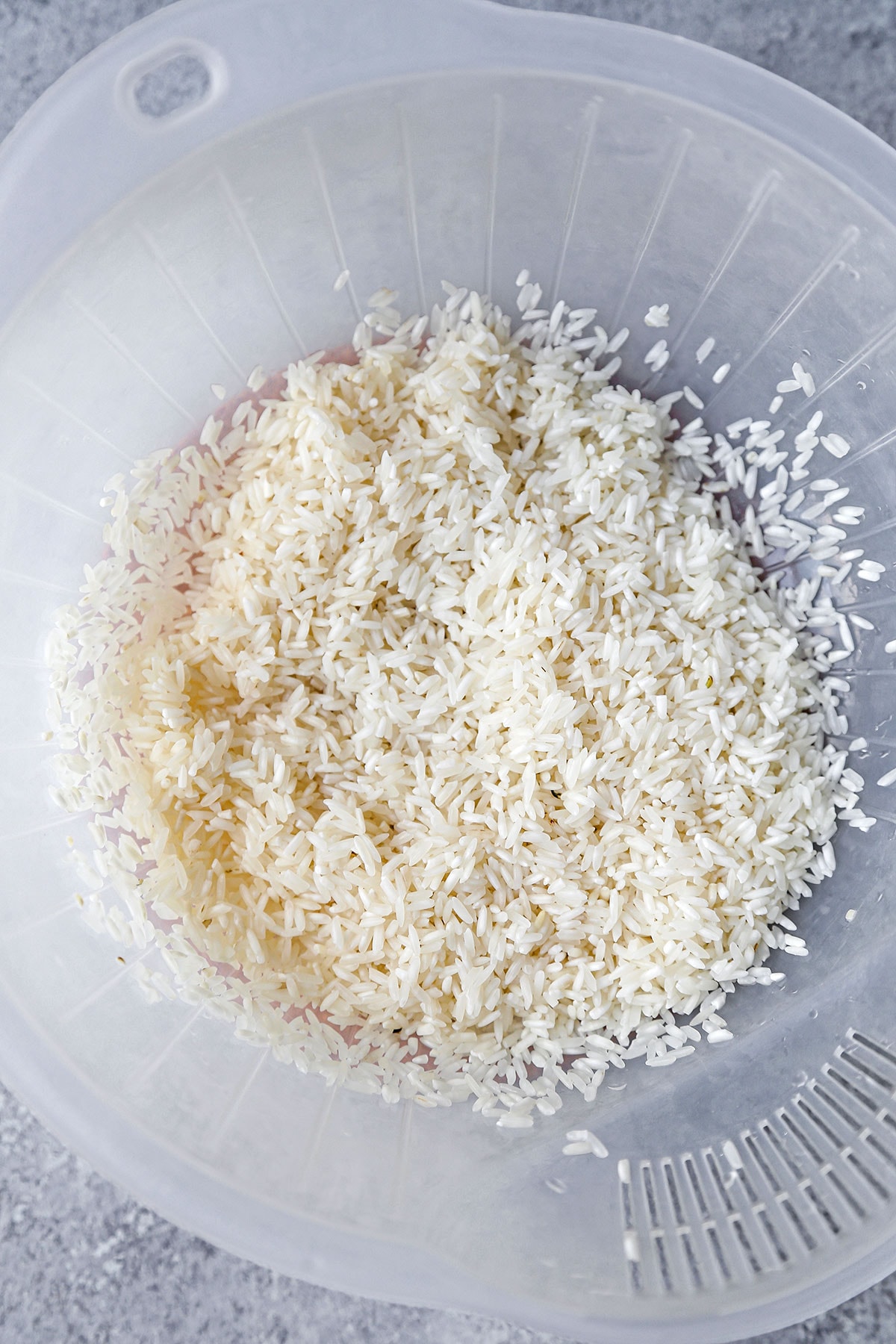
Ingredients for congee
- Rice: It always surprises me how such a small amount of rice goes so far when making congee. You’ll only need about a cup to make a full batch. It keeps expanding as it cooks (and we’re basically overcooking it). I like to use medium grain or long grain rice in this Chinese rice porridge recipe.
- Ginger: When making basic congee, using thinly sliced ginger has a twofold purpose. Not only does it deliver a tingling slow burn to the flavor, it also can help settle an upset stomach.
- Broth: Simmering your rice in low sodium chicken broth will introduce a delicate undertone without making the dish overly salty. If you prefer to use dashi (Japanese sea stock), you’ll get a mildly fishy broth full of umami. You can learn how to make dashi from scratch in this tutorial. Vegans can make a vegetarian congee by using kombu dashi (seaweed dashi). Grab it at your local Asian grocery store – or pick it up on Amazon.
- Kosher Salt: Since kosher salt has larger crystals, it’s harder to oversalt this easy congee recipe than if you used regular iodized salt.
Popular Congee Toppings
As I mentioned, the toppings you choose can be as simple or as complex as you would like. While you can technically use any ingredient to compliment your rice porridge, here are some of the more popular ones used in China, Japan, and Korea:
- Egg: Whether it’s a salted duck egg, a ramen egg, a Chinese tea egg, or just a simple poached egg, their creaminess makes for a delicious addition.
- Green onions: They add a little sweetness and a refreshing crunch.
- Fried tofu: I like to use sliced fried tofu pouches instead of regular fried tofu. They are tender and infuse the broth with a nutty taste.
- Fried garlic: Fried garlic add a smokey and slightly sweet element.
- Fried shallots: Fried shallots also add smokiness and sweetness, and a lovely crunch.
- Chicken: You can use chopped leftover chicken, roast chicken, or a freshly cooked piece of chicken.
- Kimchi: Kimchi adds plenty of pungency, saltiness, and acidity.
- Pickled plum: One of my favorite okayu toppings, pickled plum (umeboshi) has a very unique taste that’s hard to describe. It’s a mix of sweet, salty and sour.
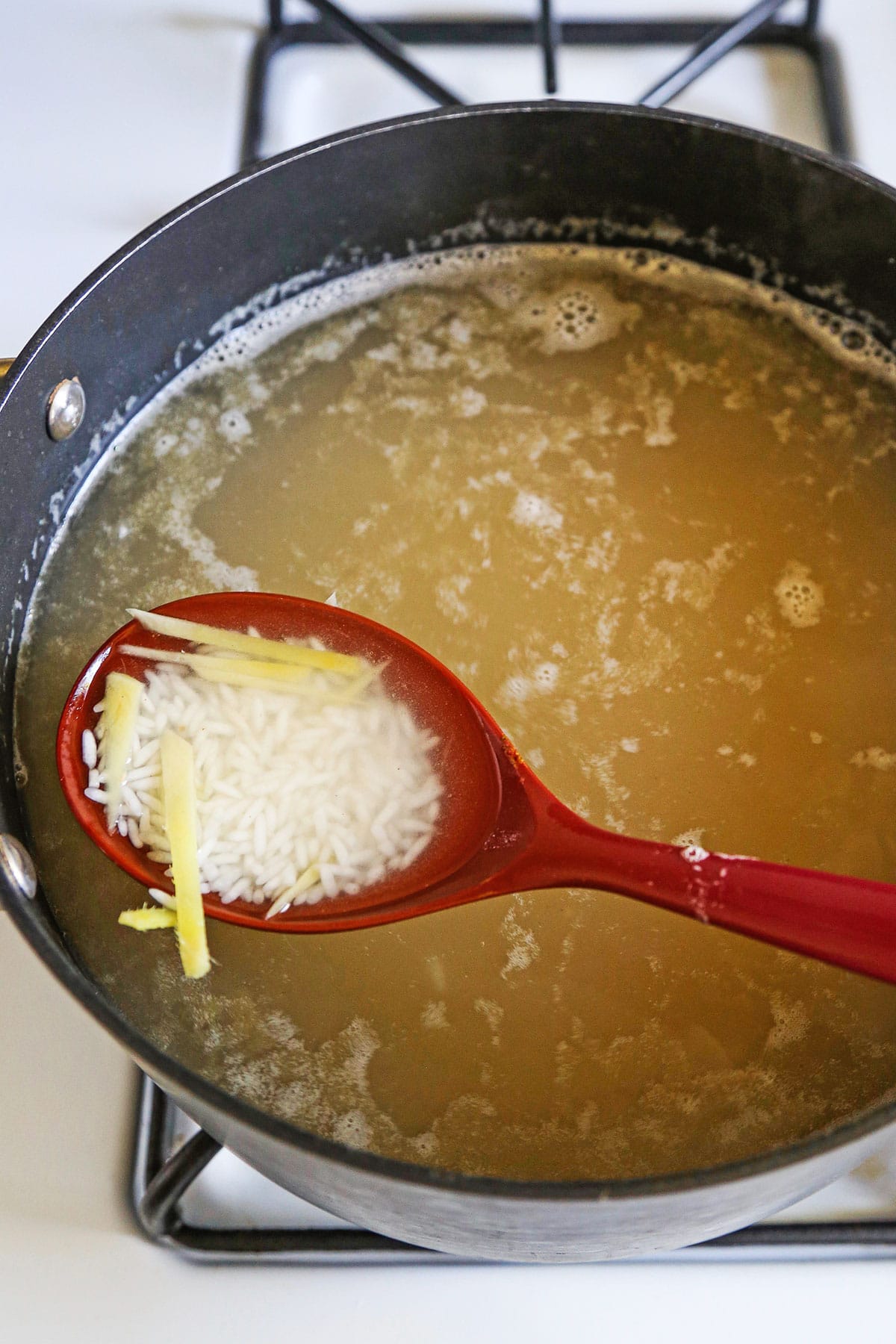
How to Make Congee
- Rinse your rice in cold water to move excess starch. You may need to rinse and drain your rice multiple times – until the water is clear. Drain well and transfer to a bowl. Fill the bowl with fresh cold water until the rice is submerged and soak for 20 minutes. Then drain the uncooked rice again.
- In a large pot, add the broth (or dashi) and bring to a boil. Add the rice, ginger and salt and stir. Lower the heat to a simmer, cover and cook for 1 hour, stirring once in a while. Add more broth or water if the consistency starts to look too thick.
- Serve with toppings of your choice.
Making Congee in a Rice Cooker
Making congee in a rice cooker is very easy! And if you are lucky, your rice cooker may even have a porridge setting that makes the entire cooking process seamless. The only downside to using a rice cooking is the amount of congee that can be made. Regular size rice cookers can hold about 5.5 cups, which means that you will need to make a little less than half of what this recipe calls for.
- 1 tablespoon ginger, peeled and thinly sliced
- 1/2 cup medium or long grain rice
- 4 1/2 cups water
- 1/4 teaspoon salt
Follow the same step for washing your rice. Add all the ingredients to the rice cooker and select the porridge setting. If your rice cooker does not have that setting, select the regular cooking cycle and leave the lid open, otherwise the rice and water will bubble and foam. Cook the rice for about 45 minutes. If the cooking cycle ends before it’s been 45 minutes, leave it on ‘keep warm’ until the rice is fully cooked. Add more broth to the congee to adjust the thickness.
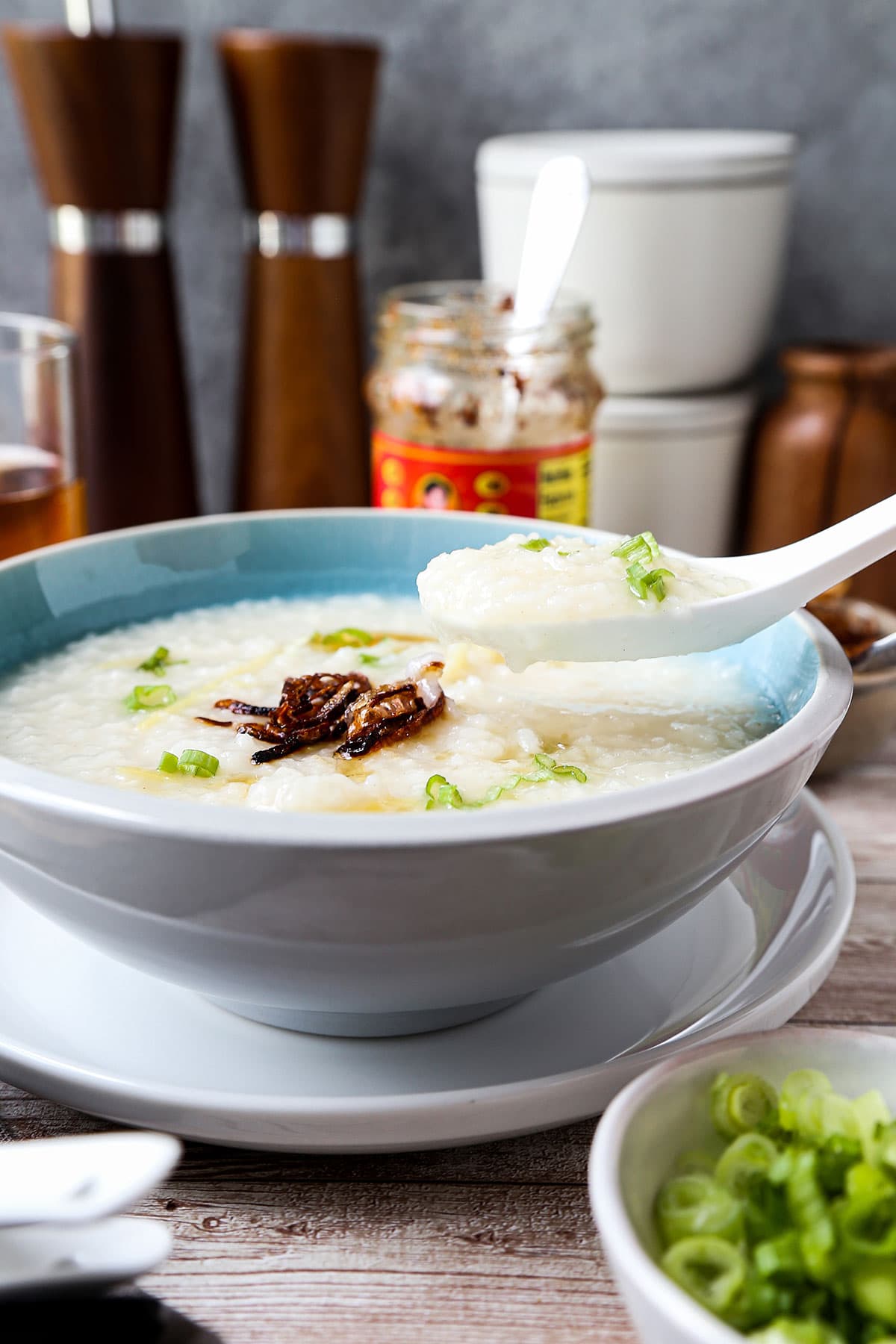
Water Ratio
When it comes to how much water to add to make the perfect congee, it really comes down to personal preference.
If you like a thick rice porridge similar in texture to a rice pudding, use less. If you prefer it to be closer to a soup, use more. There isn’t a specific rice to water ratio when making Chinese congee. And if you aren’t sure of how thick or thin you like it, the good thing about this dish is that it’s very easy to fix.
If your congee is too thick, add more broth or water. If your congee is too thin, leave the lid off the pot and cook it for longer to let some of the liquid evaporate.
Storage
Fridge: Once the congee has cooled down to room temperature, transfer it to a storage container. It will keep refrigerated for up to 5 days.
Freezer: Let the congee cool down to room temperature first. Use storage bags and divide the congee into single serving sizes. Seal the bags and freeze them flat on top of one another. They will keep in the freezer for up to 2 months.
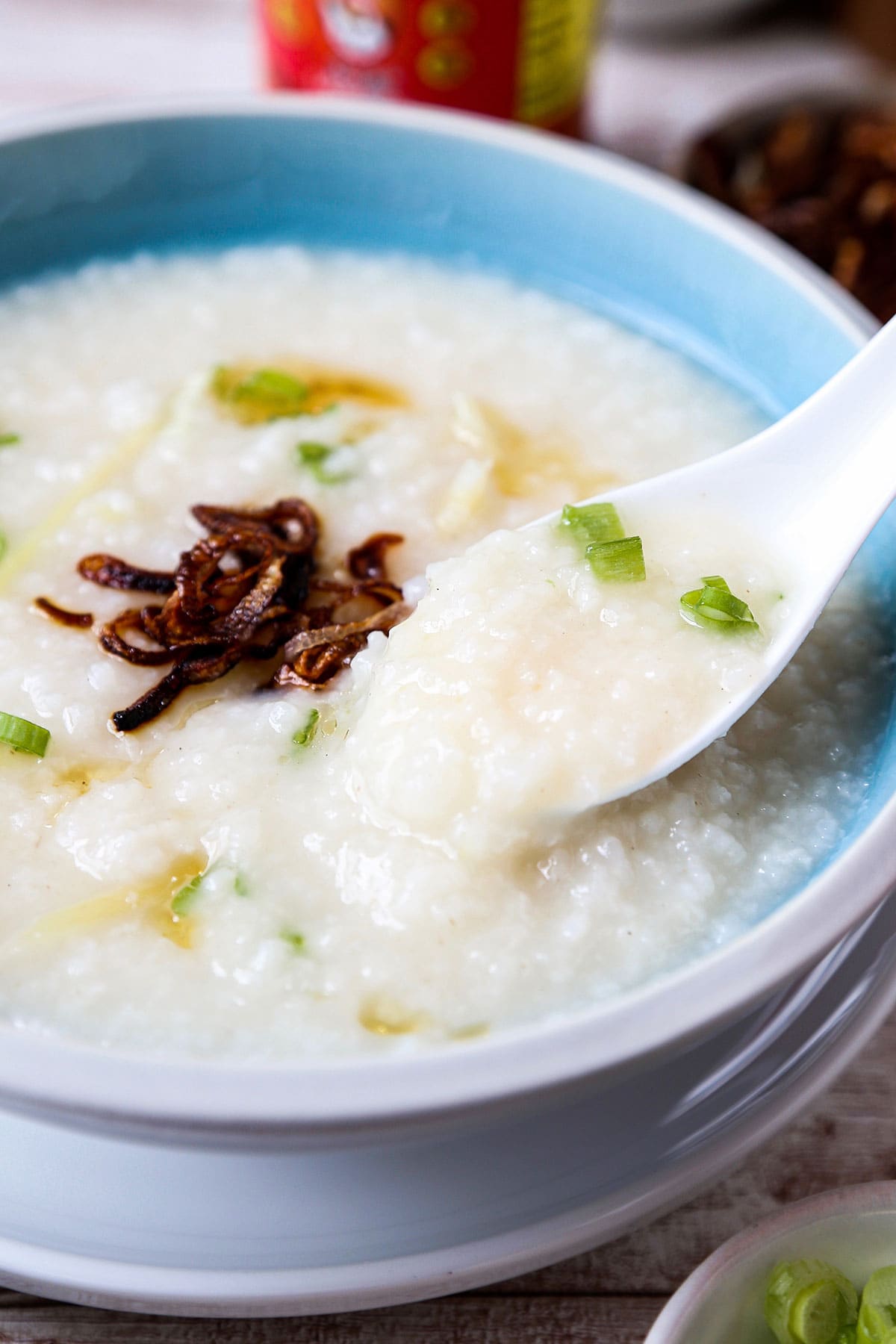
Frequently Asked Questions
Yes, plain congee is gluten-free. The toppings on the other hand may not be. For example, ramen eggs are marinated in soy sauce which contains gluten.
The main difference is in the rice texture – while the rice in congee is cooked to the point of disintegration, the rice in porridge remains whole and gives the dish and richer, thicker texture. Also, porridge can be served sweet while congee is known as a savory dish.
Yes you should always wash rice before using it to get the best possible texture. The reason for washing rice is to remove the extra starch (which is what makes the water turn cloudy) which can give the rice and gummy, sticky texture.
What to Serve with Congee
Congee can be served as a main dish, with a variety of toppings on the side. Because it’s so delicate in flavor, you can serve it with stronger dishes such as:
- Chinese eggplant with garlic sauce
- Vegetable egg rolls
- Crispy honey sriracha tofu
- Bok choy with garlic and oyster sauce
Subscribe to my newsletter and receive the latest recipes and weekly favorites straight to your inbox. Join me on Pinterest, Facebook, and Instagram for more cooking tips and adventures!
Did you like this congee recipe? Are there changes you made that you would like to share? Share your tips and recommendations in the comments section below!
Print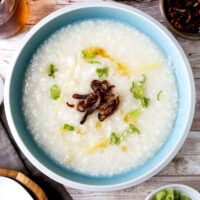
Basic Congee Recipe – 粥
- Prep Time: 10 minutes
- Cook Time: 60 minutes
- Total Time: 70 minutes
- Yield: 6 1x
- Category: Rice Recipes
- Method: Simmered
- Cuisine: Chinese
- Diet: Low Calorie
Description
This creamy and savory congee recipe is the perfect breakfast food, and a comforting meal for when you are feeling under the weather.
Ingredients
- 1 thumb size ginger, peeled and thinly sliced
- 1 cup medium or long grain white rice
- 10 cups low sodium chicken broth or dashi broth (use wakame seaweed dashi for vegan)
- 1/2 teaspoon salt
Toppings (optional)
- Green onions
- Sesame oil
- Fried tofu
- Fried shallots
- Chicken
Instructions
- Rinse the rice to remove excess starch, drain well and transfer to a bowl. Fill the bowl with water until the rice is submerged and soak for 20 minutes. Then drain the uncooked rice again.
- In a large pot, add the broth and bring to a boil. Add the rice, ginger and salt and stir. Lower the heat to a simmer, cover and cook for 1 hour. Add more water if the consistency is too thick.
- Serve with toppings of your choice.
Notes
Leftover congee can be kept covered in the fridge for up to 5 days.
Nutrition
- Serving Size: 1 serving
- Calories: 180
- Sugar: 0.6g
- Sodium: 314mg
- Fat: 2.7g
- Saturated Fat: 0.8g
- Unsaturated Fat: 0.6g
- Trans Fat: 0g
- Carbohydrates: 29.8g
- Fiber: 0.6g
- Protein: 10.3g
- Cholesterol: 0mg
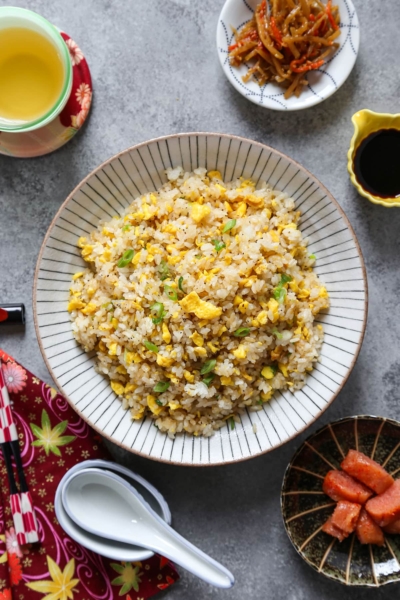
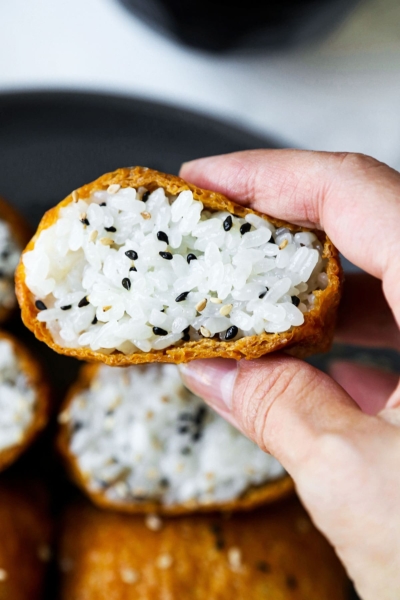
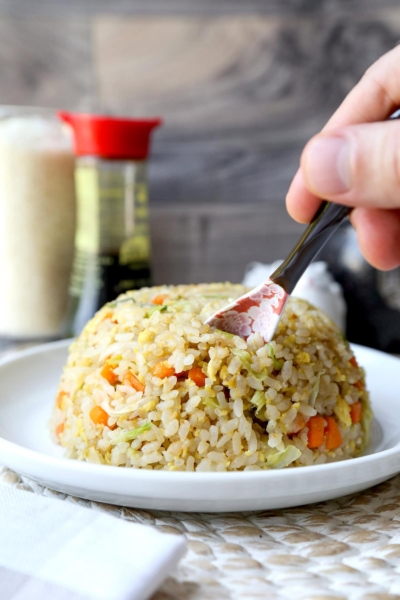
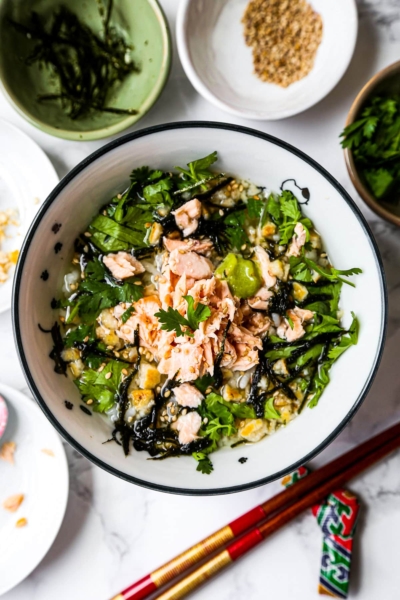















Questions and Reviews
Love this recipe!! Just made it to help settle my sick stomach— first meal I managed to digest 🙂 Highly recommend if you’re unwell or just want comfort food
Thank you Julianna! 🙂
Absolutely adore this! I usually end making a double batch and add a little garlic and use vegetable broth to make it vegan.
Thank you so much Sydney! 🙂
I’m lazy and vegan, so I made the congee in an Instant Pot with no-chicken bouillon! 15 minutes on high pressure with the same measurements and about a teaspoon of the bouillon. Perfect for me since I just had gum surgery and have to eat soft foods. So happy I finally tried it!
That’s wonderful Rebecca! I hope the healing is a painless as it can be!
2. In a large pot, add the broth and bring to a boil. Add the rice, ginger and salt and stir. Lower the heat to a simmer, cover and cook for 1 hour. Add more water if the consistency is too thick.
10 cups broth and 1 cup rice and simmer one hour? This seems like a lot of broth to get thick in the allotted time. Is this correct?
Hi Larry, yes this is correct. The rice will thicken slowly and create a silky porridge. It’s delicious!
Love the simplicity and the authentic results! My go to Congee recipe. The only one I’ll use.